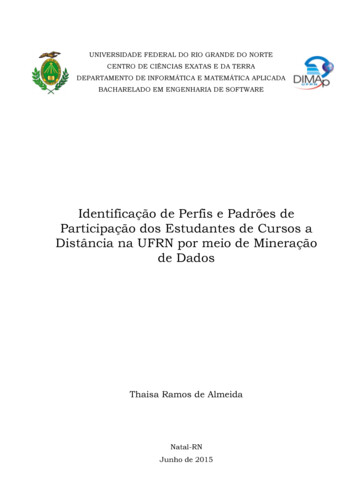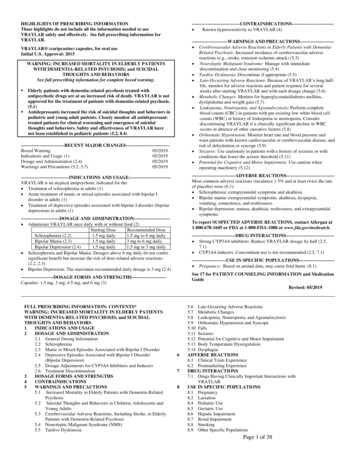
Transcription
Translational PsychiatryREVIEW ARTICLEwww.nature.com/tpOPENFunctional neuroanatomy of maniaGonçalo Cotovio1,2,3 and Albino J. Oliveira-Maia1,2 The Author(s) 20221234567890();,:Mania, the diagnostic hallmark of bipolar disorder, is an episodic disturbance of mood, sleep, behavior, and perception. Improvedunderstanding of the neurobiology of mania is expected to allow for novel avenues to address current challenges in its diagnosisand treatment. Previous research focusing on the impairment of functional neuronal circuits and brain networks has resulted inheterogenous findings, possibly due to a focus on bipolar disorder and its several phases, rather than on the unique context ofmania. Here we present a comprehensive overview of the evidence regarding the functional neuroanatomy of mania. Ourinterpretation of the best available evidence is consistent with a convergent model of lateralized circuit dysfunction in mania, withhypoactivity of the ventral prefrontal cortex in the right hemisphere, and hyperactivity of the amygdala, basal ganglia, and anteriorcingulate cortex in the left hemisphere of the brain. Clarification of dysfunctional neuroanatomic substrates of mania maycontribute not only to improve understanding of the neurobiology of bipolar disorder overall, but also highlights potential avenuesfor new circuit-based therapeutic approaches in the treatment of mania.Translational Psychiatry (2022)12:29 ; TIONMania is an episodic disturbance of mood, sleep, behavior, andperception. It is characterized by expansive, elated and/or irritablemood, increased energy, grandiosity, lack of sleep, impairedthinking, and poor judgment [1]. Importantly, the recurrence ofsuch episodes has been identified as the diagnostic hallmark ofbipolar disorder (BPD) and other bipolar spectrum disorders,estimated to affect 3–6% of the world population [2]. Due to itsimpact on patient functioning, commonly resulting in clinical,interpersonal, financial, and even legal consequences, mania isconsidered a very debilitating mental health condition, not onlyfor patients suffering from this mood disorder but also for theirfamily and friends [3].Despite such relevant effects on patient well-being [4],diagnosis and treatment of mania is still a clinical challenge[5, 6], possibly due to a poor understanding of the underlyingneurobiology [7, 8]. Different potential mechanisms for thepathophysiology of affective disorders, including mania, havebeen suggested. These include the dysregulation of synapticneurotransmission, namely that of glutamate and its action onNMDA receptors [9, 10], which have also been shown to bepromising treatment targets for affective disorders [11, 12]. Onthe other hand, dysregulation of synaptic plasticity, impacted atthe molecular level by impaired function of microRNAs intranslational regulation, has also been suggested as anotherpotential mechanism [13]. Furthermore, several authors haveproposed a neuroanatomical dysfunction substrate for maniapathophysiology, focusing on the impairment of functionalneuronal circuits and brain networks (see Strakowski et al. for acomprehensive review of the functional neuroanatomy of BPD[14]). Nevertheless, previous clinical research has focused mainlyon BPD, making the results difficult to interpret in the uniquecontext of mania, with heterogenous and sometimes evencontradictory findings. In fact, the cause for ambiguity in thesefindings may lay on the differences between trait- and statedependent changes, which have been reported across severalneuropsychiatric disorders [15], but may be particularly relevantin episodic mood disorders such as BPD. Here, some changesmay occur only during an acute episode of mood disturbanceand disappear once the symptoms remit (i.e., state) while otherchanges may be present during acute episodes as well as duringeuthymia (i.e., trait) [16]. Ultimately, the distinct clinicalcharacteristics of mania, depression, mixed episodes, andeuthymia observed in patients with BPD may be reflected alsoin differences in neuroimaging findings, contributing towards alack of clarity regarding the unique functional neuroanatomysubstrate of mania [16].Disentangling the specificities of dysfunctional neuroanatomyin mania would be an invaluable contribution to the field. First,it would help to find state-dependent biomarkers that mayassist in the differential diagnosis of mania, depression, andeuthymia, and, most importantly, also in more challenging casessuch as mixed affective episodes, subthreshold (hypo)mania, orlatent bipolarity in unipolar depression [17]. Second, it wouldcontribute to the overall understanding of BPD neurobiologyand its neural pathophysiology. Finally, it may ultimately alsoguide research of specific innovative treatment strategies formania [18, 19]. The current manuscript, rather than a systematicreview of the current literature, is a comprehensive overview ofthe evidence regarding the functional neuroanatomy of mania.It aims to summarize the best available evidence, creating aconvergent model for mania circuit dysfunction, while subsequently highlighting potential avenues for development of newtherapeutic approaches for mania.1Champalimaud Research and Clinical Centre, Champalimaud Foundation, Lisbon, Portugal. 2NOVA Medical School, NMS, Universidade Nova de Lisboa, Lisbon, Portugal.Departamento de Psiquiatria e Saúde Mental, Centro Hospitalar de Lisboa Ocidental, Lisbon, Portugal. email: albino.maia@neuro.fchampalimaud.org3Received: 19 April 2021 Revised: 21 December 2021 Accepted: 7 January 2022
G.çalo Cotovio and A.J. Oliveira-Maia2METHODSThe search was performed on MEDLINE/PubMed and GoogleScholar between December 2020 and April 2021. Search termswere: “Functional” AND “Neuroanatomy” AND “Mania”. Articles inEnglish, French, Portuguese, or Spanish were considered, regardless of the publication date or country of origin. To be consideredin our review, articles had to report functional neuroimagingfindings, namely functional magnetic resonance imaging (fMRI),positron emission tomography (PET) or single-photon emissioncomputed tomography (SPECT), in patients with bipolar disorder,during a manic episode. Clinical trials, cohort studies, case-controlstudies, case series, systematic reviews, and meta-analysis wereincluded. While evidence from single case reports was excluded,their reference lists were screened for additional articles, as werethose from the included articlesDisrupted functional brain networks in primary maniaFunctional neuroanatomy of mania has been obtained fromdifferent neuroimaging studies, conducted mainly in patients withprimary idiopathic mania, the majority of cases of mania, where aclear medical or toxic cause for the episode cannot be identified.The neuroimaging approaches used have mostly varied from fMRIto PET, taking advantage of several task-based and resting-stateprotocols [20–22]. Furthermore, different research designs havealso been explored to clarify dysfunctional circuits associated withmania, through comparisons of patients with mania with healthysubjects, with the euthymic state, and/or with other neuropsychiatric syndromes, such as unipolar or bipolar depression [21, 22].When considering the results from previously published metaanalyses addressing functional neuroimaging findings in mania,key limbic regions were shown to have impaired activity inpatients with mania when compared to healthy volunteers.Specifically, Chen and colleagues, based on 8 studies, reportedthat in mania compared to healthy the inferior frontal gyrus, i.e.,Brodmann Area (BA) 47, was hypoactive bilaterally, with apredominance on the right side, while the left thalamus washyperactive [22]. Moreover, Hajek and colleagues, in a metaanalysis of 10 functional imaging studies involving responseinhibition paradigms, further confirmed that patients with maniashowed lower activation not only in right inferior frontal gyrus(BA47) but also in the right medial frontal gyrus (BA9), and greateractivation in the right insula (BA13) and bilateral basal ganglia [23].Interestingly, in this meta-analysis, but not in Chen et al., loweractivation of right inferior frontal gyrus (BA47), was found inbipolar disorder irrespective of mood state (euthymia or mania),suggesting that right inferior frontal gyrus hypoactivation shouldbe further explored as a potential trait marker for bipolar disorder.Conversely, while Hajek et al. did not report significant changes inamygdalae, Chen et al. showed decreased activity of the rightamygdala and increased activity of the left amygdala, alongsideother meso-temporal structures such as parahippocampal gyrusand hippocampus, when considering jointly studies includingmania and euthymia. Some reports of the functional neuroanatomy of mania were not included in these meta-analyses, possiblydue to exclusion criteria related to experimental design, such astype of neuroimaging modality or even specific task paradigms.Additionally, since the publication of these meta-analyses, morestudies reporting on functional neuroimaging findings in thecontext of mania have been published. For a more completeunderstanding of the functional neuroanatomy of mania, theresults of these studies are also included in Table 1.One of the most consistent findings in the functionalneuroanatomy of mania has been hyperactivity of the leftamygdala in response to emotional cues, observed whencomparing mania with healthy in fMRI studies [24–26], and alsofound to correlate with severity of mania symptoms [25].However, when comparing mania with euthymic state in bipolardisorder, left amygdala hyperactivation was not found and,rather, decreased activation of the right amygdala was observed[27]. Together, these findings support the hypothesis that activityimbalance between left (elevated) and right (reduced) amygdalaeis an important functional neuroimaging correlate of mania [28].However, it is important to also consider that another study hasshown a bilateral reduction in amygdala activity in mania relativeto healthy subjects [29], and others have failed to show anypattern of differences in amygdala activation in mania relative tohealthy subjects [14, 30]. Nevertheless, it would be interesting toexplore, across studies, potential differences in the right-leftimbalance of amygdala activity between patients with mania andhealthy volunteers. Importantly, fMRI findings in other mesotemporal structures support the hypothesis of lateralizedimbalance of activity, with decreased activity in the righthippocampus and parahippocampal gyrus of patients with mania,during cognitive and emotion-associated tasks, when comparingwith healthy subjects and to euthymia [27, 31]. Overall, thesefindings support that activity in the amygdala and other mesotemporal hubs of emotional networks in the limbic system[16, 32–34] is dysregulated in mania, with most studies pointingtowards increased activity in the left hemisphere or decreasedactivity on the right.The prefrontal cortex (PFC) has also been consistently reportedas a key region for the regulation of emotional behavior [32], andits dysfunction has been associated with mood disorders [35].Noteworthy, the PFC is a complex structure [36] that, in addition tocontributing to emotional regulation, has also been associated withdifferent cognitive functions, such as working memory, attention,reward appraisal, and decision-making, functions that are supported by multiple reciprocal connections to distinct brain regions[36, 37]. Probably due to such multi-domain functions, while PFChas been persistently implicated in the functional neuroanatomy ofmania, its specific role has been difficult to interpret [38].Nevertheless, in fMRI and PET studies, assessing response toemotional stimuli [24, 26, 27, 39], response-inhibition tasks [31], anddecision-making paradigms [40], the most consistent findings inmania relative to healthy subjects have been reduced activation onthe right side of the brain or bilaterally in the ventrolateralprefrontal cortex (VLPFC), a brain region including the lateralorbitofrontal cortex [lOFC, also designated as Brodmann area (BA)47 or BA47/12 due to correspondence of human BA47 to monkeyBA12 [36, 41–44]; also see Fig. 1]. Similarly, in mania relative tohealthy subjects, reduced activation has also been described in theright ventromedial prefrontal cortex (vmPFC), a heterogenous brainregion that includes parts of the anterior cingulate cortex (ACC),namely BA25 and BA32, the middle frontal gyrus, namely BA10,and regions of the medial OFC (mOFC), such as BA11, BA12, andBA14 [36, 40, 44, 45] (Fig. 1). Interestingly, in a PET study,hypoactivity of the right BA10 and right BA11, areas included inVMPFC, was also observed during a word generation task whenpatients with mania were compared to euthymic state [46].Moreover, in the same study, hypoactivity of the right BA10 andbilateral OFC, during a word generation task and in resting state,respectively, was also detected when patients with mania werecompared to healthy subjects [46]. These results further supportthat under-activation of these regions may be a neuroimagingbiomarker of mania. However, in what possibly reflects thecomplex roles of the PFC in human behavior, in another study,when compared to healthy subjects, patients with mania had bothdecreased and increased activation of left VMPFC and VLPFC,during gain and loss expectation states, respectively, in a rewarddecision-making task [47]. Furthermore, in fMRI during a workingmemory task, patients with mania had increased activation of theVMPFC bilaterally, relative to healthy subjects, while the activity ofthe left dorsolateral prefrontal cortex (DLPFC) was reduced [48].Considering all the evidence above, it seems that the PFC ishypoactive in patients with mania, particularly in the righthemisphere, in certain cognitive and decision-making contexts.Translational Psychiatry (2022)12:29
G.çalo Cotovio and A.J. Oliveira-Maia3Table 1.Functional neuroimaging findings during primary mania bler et al. 2008NAc.Bilateral HSfMRIReward taskAbler et al. 2008NAc.Bilateral Schiz.fMRIReward taskAlonso‐Lana et al. 2019VMPFCDLPFC/PC (BA6)Parietal cortex/superior precuneusBilateralLeftBilateral fMRIWorking memory taskVMPFCDLPFC/PC (BA6)Parietal cortex/superior precuneusBilateralLeftBilateral fMRIWorking memory taskAltshuler et al. 2005aAmygdalaLateral OFCLeftBilateral HSfMRIAffect-laden taskAltshuler et al. 2005bLateral OFC (BA47)HippocampusCingulate cortex (BA24)RightRightLeft HSfMRIGo-No Go taskBermpohl et al. 2009AmygdalaLeft HSfMRIAffect-laden taskBermpohl et al. 2010bLateral OFCLateral OFCVentral striatumPCCLeftLeftNDRight c d HSfMRIReward taskBlumberg et al. 1999MFG (BA10)OFC (BA11)RightRight Euth.ePETWord generation taskBlumberg et al. 1999MFG (BA10)Right HSPETWord generation taskBlumberg et al. 1999OFCBilateral HSPETResting stateBlumberg et al. 2000Dorsal ACCHead of caudateLeftLeft Euth.ePETResting stateCaligiuri et al. 2003Globus pallidusThalamusCaudateLeftRightRight BDefMRIReaction-time taskCaligiuri et al. 2003SMA (BA6)Globus pallidusPMA (BA4)LeftLeftRight HSfMRIReaction-time taskChen et al. 2010AmygdalaHippocampusRightRight Euth.afMRIAffect-laden taskChen et al. 2010OFCCaudateRightLeft HSfMRIAffect-laden taskDrevets et al. 1997fSubgenual prefrontal cortexND HSPETResting stateFoland et al. 2008AmygdalaVLPFC (BA47)LeftBilateral HSfMRIAffect-laden taskLennox et al. 2004InsulaPCCAmygdalaSubgenual ACCLeftNDBilateralND HSfMRIAffect-laden taskLiu et al. 2012Rostral prefrontal cortex (BA10)Right HSfMRIAffect-laden taskMazzola-Pomietto et al. 2009VLPFCBilateral HSfMRIGo-No Go taskRubinsztein et al. 2001Dorsal ACC (BA32)VMPFC (BA10)IFG (BA47)LeftRightBilateral HSPETDecision-Making taskStrakowski et al. 2008PCC (BA23, BA29)ACC (BA32)ThalamusPrecuneus (BA7, BA39)Middle temporal gyrus (BA21, BA37)BilateralLeftLeftLeftLeft HSfMRIResponse-inhibition taskStrakowski et al. 2011AmygdalaFusiformVLPFCACCCerebellar alRightNDRightRightLeftRight g g g g gHSfMRIAffect-laden taskAlonso‐Lana et al. 2019Translational Psychiatry (2022)12:29 Euth.a HS
G.çalo Cotovio and A.J. Oliveira-Maia4Table 1.ArticlecontinuedRegionLingual gyrusMedial RightRightActivity g ControlStudyTask – similar, increase, reduced, ACC anterior cingulate cortex, BA brodmann area, BD bipolar depression, DLPFC dorsolateral prefrontal cortex, Euth.euthymic state, fMRI functional magnetic resonance imaging, HS healthy subjects, IFG inferior frontal gyrus, MFG middle frontal gyrus, NAc. nucleus accumbens,ND not defined, OFC orbitofrontal cortex, PC precentral cortex, PCC posterior cingulate cortex, PET positron emission tomography, PMA primary motor area,Schiz. schizophrenia, SFG superior frontal gyrus, VLPFC ventrolateral prefrontal cortex, VMPFC ventromedial prefrontal cortex.aWithin-subject analysis.bAfter symptoms remission no differences were found between manic remitted patients and healthy subjects in OFC activity.cDuring expectation of increasing gain in the reward task.dDuring expectation of increasing loss in the reward task.eBetween-subject analysis.fUnipolar and bipolar depressed patients had decreased activation in subgenual prefrontal cortex relative to healthy subjects.gOverall resulting activity differ according to the analysis performed and/or to the specific fMRI task cue.Fig. 1 Neuroanatomy of ventrolateral and ventromedial prefrontal cortices. While there is variability in the nomenclature and in theorganization of ventrolateral (A) and ventromedial prefrontal cortices (B), this diagram represents previously suggested models [36, 40–45] forthe neuroanatomy of these structures, focusing on regions and areas that are critical for interpretation of the functional neuroanatomyof mania.Another region of interest that has been reported to beimpaired in mood disorders [35, 49], including mania [35], is thecingulate cortex, particularly the anterior cingulate cortex (ACC),also designated as BA24, 25, and 32 [50] (Fig. 1). In fact, thesebrain regions have been considered part of the VMPFC, and theirrole has been implicated in several functions related to the PFC[45]. Hence, as is the case for the prefrontal cortex, a role for theACC within a global vision for the functional neuroanatomy ofmania has been difficult to establish [38]. When comparingpatients with mania and healthy controls in fMRI studies, theformer had reduced activation of the ACC in a Go-No Go task [31]and in response to emotional cues [29], but increased activationin working memory [48] and response-inhibition tasks [51]. Onthe other hand, in PET studies, patients with mania hadincreased activation of left ACC in resting state [35] and duringa decision-making task [40], relative to healthy subjects, as wellas when compared to euthymia [52]. Importantly, in patientswith both unipolar and bipolar depression, ACC activity wasfound to be decreased in similar conditions [35]. Moreover, asdescribed above for the left amygdala [25], there is a positiveassociation between left ACC activity and severity of maniasymptoms [40]. Thus, there is evidence for left-sided hyperactivity of the ACC in mania, while in certain conditions this areacan be inappropriately hypoactivated.Several subcortical structures have also been implicated in maniacircuit dysfunction, the basal ganglia in particular [14, 22, 38].Patients with mania had increased activity in the left basal ganglia,namely the globus pallidus and caudate, in a reaction-time task [53]and in response to affective simuli [27], when compared to healthysubjects, as well as bipolar depression [53] and euthymia [52].Interestingly, and similar to what was described above forlateralized dysfunction of the amygdala, reduced activation of theright caudate in a reaction-time task was found in mania whencompared to bipolar depression [53]. Nevertheless, the availableevidence is mostly supportive of hyperactivity of the left basalganglia in mania, supporting the importance of such structures inthe regulation of emotional behavior [54, 55]. While other corticaland subcortical regions have also been implicated in the functionalneuroanatomy of mania, these findings have not been consistentlyreplicated, and cannot be appropriately interpreted in the currentstate of the art. Among others, they include not only increasedactivation of left supplementary motor area [53], left insula [29], andbilateral posterior cingulate [29] but also reduced activation of rightprimary motor cortex [53], right posterior cingulate [47], supplementary motor area [48], bilateral parietal cortex [48], bilateral [48]or left [51] precuneus, left middle temporal gyrus [51], left [51] andright [53] thalamus, and bilateral nucleus accumbens [56].Noteworthy, three studies reported functional neuroimagingchanges before and after mania treatment, i.e., in mania vs.euthymic state, using within-subject analyses. Two of these studiesreported bilateral VMPFC (BA11) hyperactivity that remained aftertreatment [27, 48], suggesting that this may be a potential traitTranslational Psychiatry (2022)12:29
G.çalo Cotovio and A.J. Oliveira-Maia5Fig. 2 Functional neuroanatomy of mania. Evidence from different functional neuroimaging studies suggest that there is a reduced activityof right ventromedial and ventrolateral prefrontal cortices and an increased activity of left amygdala, left anterior cingulate cortex, and leftbasal ganglia in mania.biomarker for bipolar disorder. These findings are inconsistent withthe third longitudinal study reporting that, in a reward decisionmaking task, patients with mania no longer showed activitychanges in left VMPFC and VLPFC after symptom remission [47].Such heterogeneity of results supports a complex role for theVMPFC in the functional neuroanatomy of mania, further supportedby the fact that, in response to certain stimuli, BA10/BA11 ishypoactive in patients with mania compared to a different group ofeuthymic patients, using between-subject analyses [46], while inresponse to other stimuli BA11 is inappropriately activated inpatients with bipolar disorder, irrespective of mood state [27, 48].These longitudinal studies have also suggested candidates for statemarkers of mania, that were not observed when patients enteredeuthymia. In fact, in comparisons to euthymic state, patients duringmania were reported to have decreased activation in left DLPFC/precentral cortex (BA6) and bilateral superior parietal cortex/precuneus (BA7) by some authors [48], or in the right hippocampusand right amygdala by others [27]. Moreover, considering that leftamygdala hyperactivity is a consistent finding in mania [24–26], it isalso reasonable to consider that imbalanced activity between theleft (elevated) and right (reduced) amygdalae may be a moreaccurate correlate of mania [28]. Further and better poweredlongitudinal studies, with experimental designs explicitly assessingdifferences in activity between the right and left hemispheres, arenecessary to clarify potential roles for the activity of these brainregions as state markers of mania, or trait markers of bipolardisorder, ideally while resolving conflicting findings from previousstudies [27, 46]From the evidence presented above, in meta-analyses as well asseveral of the individual original studies, we hypothesize thatmania is characterized by lateralized dysfunction of the limbicsystem, mainly involving the left amygdala, right (or bilateral)ventral PFC, left ACC, and left basal ganglia (Fig. 2). Not surprisingly,reciprocal connections between many of these regions, inparticular the amygdala and PFC, have been shown to bedisrupted. Relative to healthy controls, in patients with mania,the left amygdala was more negatively connected to the left ACCand right VMPFC [26], but less connected to the left caudate andputamen [57], and left [57] or bilateral [26] VLPFC, while the rightamygdala was more connected to the right hippocampus [57].Interestingly, negative connectivity from the left amygdala tobilateral VLPFC was negatively associated with mania symptomTranslational Psychiatry (2022)12:29severity [26]. Moreover, in patients with mania, both amygdalaewere less connected not only to the ACC in comparisons witheuthymic patients with bipolar disorder [58], but also to the VLPFCand striatum in comparisons with healthy controls [57]. Finally,within PFC regions, patients with mania had increased positiveconnectivity between the right VLPFC and bilateral medial PFC,and reduced negative connectivity between bilateral medial PFCand bilateral DLPFC, when compared to healthy subjects andpatients with schizophrenia [59], while the ACC was less connectedto the left OFC in comparisons with healthy volunteers [60]. Thereis evidence that the prefrontal cortex modulates amygdala andstriatal responses to emotional contexts and cues [61, 62], the netresult of which has been associated with emotional behaviorcorrelates [63], and with disruption of these connections possiblyassociated with affective disorders [26]. We thus propose that,during mania, a disconnection between the amygdala andprefrontal cortex [26, 32] may lead to hypoactivation of the ventralPFC, on the right hemisphere or bilaterally. Lateralized hypoactivityof the PFC may ultimately fail to modulate left amygdala activity,generating overt hyperactivity of left-sided limbic structures suchas the ACC and basal ganglia, which also have impairedconnections with the amygdala [26, 57, 58]. Nevertheless, as hasbeen previously supported by Wang and colleagues [64], futurestudies focusing specifically on functional connectivity patterns inmania and bipolar disorder may contribute towards identifyingbiomarkers for these conditions, while clarifying the role of theseconnections in the neurobiology of emotions.Interestingly, and while the development of adequate animalmodels of mania has been challenging [65–68], our hypothesis isfurther supported by evidence obtained in animal work. In proxiesof affective and cognitive features of mania, such as responseinhibition, impulsivity, and hedonic state assessed by sucrosepreference [67, 69, 70], the PFC, namely OFC and ACC, as well as theamygdala, have been consistently implicated. When these brainregions are disturbed, animals have shown mania-like behavior,such as impulsivity, increased motor activity, or increased goaldirected activity [71–76]. For example, amygdala lesions wereassociated to greater impulsivity while OFC lesions had the oppositeeffect, increasing preference for larger but delayed rewards [72].Such findings suggest that OFC is involved in evaluating theincentive value of outcomes [72] and disrupting/modulating itsactivity was associated with impaired response-inhibition and
G.çalo Cotovio and A.J. Oliveira-Maia6impulsive behavior [71]. Moreover, other regions have also beenassociated with persistent impulsive behavior when lesioned inanimal models, such as nucleus accumbens core [77, 78], which hasalso been reported to be dysfunctional in mania [56]. Interestingly,mania has also been associated to reward appraisal disturbancesand impaired response inhibition, which may explain the occurrence of disinhibition and increased goal-directed activity observedin patients during acute manic episodes [56]. Future research inanimal models assessing different behavior and cognitive constructs relevant to mania, such as reward responsiveness, rewardlearning, reward valuation, cognitive control, or social communication, according to the Research Domain Criteria (RDoC) framework[79], may provide further insight in the functional neuroanatomy ofmania. While most studies including animal models do not focus onthe association of specific cognitive functions with lateralized brainregions, one demonstrated that right-sided brain lesions werepredominantly associated with hyperactivity, a symptom alsoobserved in mania [76]. Noteworthy, the proposed model oflateralized dysconnectivity and dysfunction in mania also alignswith the mood laterality theory, a classical vision of theneurobiology of emotions [80, 81]. This theory suggests thatemotional functions are lateralized in the brain, with negative andpositive emotions associated with the function of the right and leftbrain hemispheres, respectively [80]. For example, when studyingfood-reward processing in healthy volunteers, activation of both theamygdala and orbitofrontal cortex in the left hemisphere wasobserved as a response to highly motivating incentives [82].Interestingly, mania has been associated with an elevation ofachievement motivation [8], and the mood laterality theory is thusconsistent with left-side overactivity [24–26] and right-sidedimpairment [31, 83–87] in mania. Moreover, it is also in agreementwith structural findings in neuroimaging studies of bipolar disorder(for a comprehensive review please see Blond et al. 2012 [16]).Contrary to structural neuroimaging, which may only revealstatic and/or overt neuroanatomic changes, the functionalstudies reviewed here have the advantage of offering anopportunity to clarify more complex and dynamic brainalterations. Nevertheless, there are potential limitations thatshould be considered. Functional MRI does not truly provide ameasure of brain metabolism. Instead, it relies on a bloodoxygen-level-dependent (BOLD) signal, an indirect measure ofactivity that is obtained in different contexts, tasks, and/ortime-points [20]. Depending on the design, fMRI studies canlead to inconsistent findings due to the impact of tasks [14]and/or reliability of BOLD signals [88]. On the other hand,despite being a closer reflection of brain metabolism, PET haslow spatial resolution and, given the use of ionizing radiation,may not be applied multiple times [20, 89]. These potentiallimitat
comprehensive review of the functional neuroanatomy of BPD [14]). Nevertheless, previous clinical research has focused mainly on BPD, making the results difficult to interpret in the unique context of mania, with heterogenous and sometimes even contradictory findings. In fact, the cause for ambiguity in these










